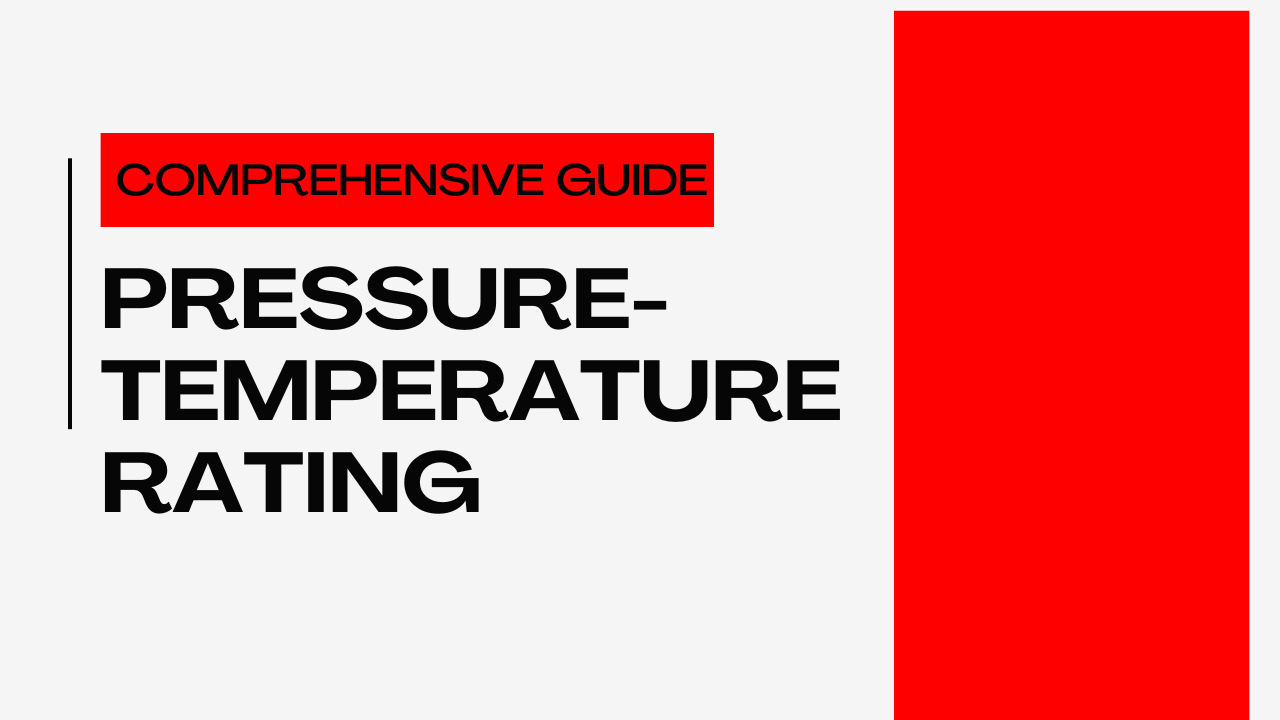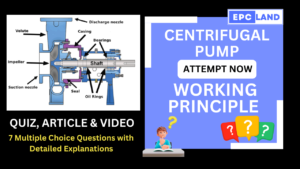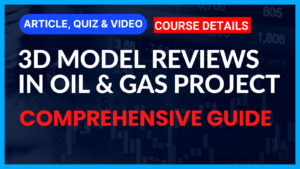Introduction
In the realm of industrial processes, the variables of pressure and temperature hold paramount importance. These two fundamental parameters influence the behavior of materials, the performance of equipment, and the overall safety of operations in industries ranging from oil and gas to power generation. Central to ensuring the integrity of equipment and preventing catastrophic failures is the concept of pressure-temperature ratings. This article aims to shed light on the critical nature of pressure-temperature ratings, their applications, and the factors that govern their determination.
Table of Contents
Don’t miss the Detailed course on 7 Modules for Piping Codes & Standards
Enrollment Link
Fundamentals of Pressure and Temperature
Definition and Measurement of Pressure
Pressure, often defined as force per unit area, is a measure of the distribution of force over a surface. It is a fundamental parameter in fluid mechanics and plays a vital role in various processes such as fluid flow, chemical reactions, and material behavior. Pressure is measured in various units, including pounds per square inch (psi), bar, and pascals (Pa). It can be categorized into gauge pressure, absolute pressure, and differential pressure, each serving a specific purpose in different applications.
Definition and Measurement of Temperature
Temperature, on the other hand, signifies the degree of hotness or coldness of an object or a substance. It influences the physical and chemical properties of materials, altering their conductivity, strength, and even phase. Temperature is typically measured in Celsius, Fahrenheit, or Kelvin. The Kelvin scale, commonly used in scientific and engineering contexts, starts at absolute zero, the theoretically lowest temperature achievable.
Similar Articles related to Pipe
| Topic | Weblink | Topic | Weblink |
|---|---|---|---|
| Pipe Insulation Materials | Link | ASME B36.10 | Link |
| Piping Codes & Standards | Link | Non-Metallic Pipes | Link |
| Pressure-Temperature Ratings | Link | Pipe Standards & Specifications | Link |
| Pipes for Different Fluids | Link | Pipe Coatings & Linings | Link |
| Pipe Materials Selection Guidelines | Link | Corrosion & Pipe Protection | Link |
| High-Temperature Pipes | Link | Pipe Dimensions & Sizes | Link |
| Pipe Manufacturing Processes | Link | Types of Pipes in Piping Systems | Link |
| Pipe Thickness Calculations | Link | Pipe Inspection & Testing | Link |
Pressure-Temperature Ratings Explained
Pressure-temperature ratings are the defined limits within which equipment can safely operate in terms of pressure and temperature. These ratings are pivotal for designing, manufacturing, and operating industrial equipment. They serve as a baseline for ensuring that equipment remains within its intended operational limits to prevent failures, leaks, and potentially dangerous situations.
Several factors influence pressure-temperature ratings:
Material Properties
Materials exhibit different behaviors under varying pressure and temperature conditions. For instance, metals may expand or contract, leading to dimensional changes that can impact equipment integrity. Brittle materials might become susceptible to fracture at low temperatures, while high temperatures could induce creep and reduce strength. Manufacturers carefully select materials that can withstand the expected pressure-temperature combinations to ensure the safety and longevity of the equipment.
Design Standards and Codes
Pressure-temperature ratings are often standardized by industry bodies and organizations to maintain consistency and safety across different applications. The American Society of Mechanical Engineers (ASME) Boiler and Pressure Vessel Code, for example, establishes guidelines for pressure vessels and boilers. Adherence to these codes ensures that equipment is designed, fabricated, and inspected according to accepted engineering practices, reducing the likelihood of failures.
Environmental Conditions
The environment in which equipment operates plays a crucial role in determining its pressure-temperature rating. Factors such as humidity, corrosive substances, and vibrations can impact the material’s performance and alter its pressure-temperature characteristics. Manufacturers must consider these external influences when determining suitable pressure-temperature ratings for their equipment.
Applications of Pressure-Temperature Ratings
The importance of pressure-temperature ratings is evident across various industries and applications:
Industrial Pipelines and Piping Systems
In the oil and gas industry, pipelines transport fluids over long distances under varying pressure and temperature conditions. Pressure-temperature ratings ensure that pipes and fittings can withstand the stress and corrosion associated with these operations. Similarly, the chemical industry relies on these ratings to prevent leaks and chemical reactions that could endanger personnel and the environment.
Pressure Vessels and Boilers
Power generation plants utilize pressure vessels and boilers to produce steam, which drives turbines for electricity generation. These vessels operate under high pressure and temperature conditions. The pressure-temperature ratings of these components are critical to preventing catastrophic failures that could result in explosions and loss of life.
Valves and Fittings
Valves and fittings are integral components of industrial processes, controlling the flow of fluids and gases. Pressure-temperature ratings guide the selection of appropriate valves and fittings for specific applications. Improper selection could lead to leakage, operational inefficiencies, and potential hazards.
Don’t miss the Detailed course on 7 Modules for Piping Codes & Standards
Enrollment Link
Material Selection and Its Impact on Pressure-Temperature Ratings
The relationship between material properties and pressure-temperature limits underscores the significance of material selection in engineering design. Different materials exhibit distinct behaviors:
Metals
Metals like carbon steel, stainless steel, and alloy steel are commonly used in industrial applications due to their mechanical strength and durability. These materials are chosen based on their resistance to corrosion, creep, and fatigue under specific pressure-temperature conditions.
Non-Metals
Non-metal materials such as plastics and composites find applications in industries where corrosion resistance and electrical insulation are crucial. However, their pressure-temperature limits are often lower than those of metals, requiring careful consideration during equipment design and selection.
Extreme Conditions
For extreme conditions involving high temperatures or pressures, specialized materials and coatings are employed. High-temperature alloys, ceramics, and refractory materials are designed to withstand intense thermal and mechanical stresses. These materials expand the operational boundaries of equipment, enabling safe performance in challenging environments.
Standards and Codes
To ensure uniformity and safety, industries adhere to established standards and codes when determining pressure-temperature ratings:
ASME Boiler and Pressure Vessel Code
The ASME Code, a widely recognized standard, provides guidelines for the design, fabrication, and inspection of pressure vessels and boilers. It covers various materials, construction methods, and pressure-temperature limits, ensuring equipment reliability and safety.
API Standards
The American Petroleum Institute (API) develops standards specifically for the oil and gas industry. These standards address pressure-temperature ratings for equipment such as pipes, valves, and wellhead components. Compliance with API standards is essential to prevent accidents and environmental incidents.
ISO Standards
The International Organization for Standardization (ISO) develops international standards that encompass various industries. ISO standards related to pressure-temperature ratings ensure consistency in equipment design, manufacturing, and testing across global markets.
Factors Influencing Pressure-Temperature Relationships
The interaction between pressure and temperature brings about various effects that influence equipment behavior:
Thermal Expansion and Contraction
As temperatures change, materials expand or contract. In equipment design, these dimensional changes must be accounted for to prevent stress, deformation, and leakage. Proper engineering design considers thermal expansion and contraction to maintain equipment integrity.
Stress and Strain
Pressure induces stress within materials, while temperature can cause them to deform or strain. The interplay between stress, strain, pressure, and temperature dictates the mechanical behavior of equipment components. Stress analysis ensures that materials can withstand these forces without failure.
Don’t miss the Detailed course on 7 Modules for Piping Codes & Standards
Enrollment Link
Safety Considerations and Failure Mechanisms
Exceeding pressure-temperature limits can lead to catastrophic failures with severe consequences:
Consequences of Exceeding Limits
When equipment operates beyond its pressure-temperature rating, it becomes susceptible to leakage, rupture, or even explosion. These failures endanger personnel, the environment, and the surrounding infrastructure. Adhering to pressure-temperature ratings is a critical safety measure.
Common Failure Mechanisms
Creep and fatigue are time-dependent failure mechanisms that occur under high temperatures and cyclic loading. Brittle fracture, often associated with low temperatures, results from the sudden propagation of cracks. Understanding these mechanisms aids in designing equipment that can withstand anticipated operational conditions.
Importance of Inspection and Maintenance
Regular inspection and maintenance are essential to monitor the health of equipment and ensure its continued safe operation. By identifying signs of wear, corrosion, or degradation, operators can take corrective actions before catastrophic failures occur.
Calculating and Applying Pressure-Temperature Ratings
Pressure-temperature charts offer a graphical representation of the safe operating envelope for different materials. Engineers and designers use these charts to select suitable materials and determine operational limits. For custom applications, advanced tools like finite element analysis (FEA) and computational fluid dynamics (CFD) allow precise calculations of pressure-temperature relationships.
Future Trends in Pressure-Temperature Technology
Advancements in materials science, coupled with technology integration, are shaping the future of pressure-temperature management:
Advances in Materials Science
Ongoing research in materials science is yielding innovative materials with enhanced properties. These materials offer increased resistance to extreme pressure-temperature conditions, opening new possibilities for equipment design and performance.
IoT and Real-time Monitoring
The integration of the Internet of Things (IoT) and sensors into industrial equipment enables real-time monitoring of pressure and temperature. This proactive approach allows operators to detect anomalies, prevent failures, and optimize equipment performance.
Simulation and Modeling Advancements
Advances in simulation and modeling techniques enable engineers to predict the behavior of equipment under various pressure-temperature scenarios. This capability reduces the need for physical prototypes and accelerates the design and testing process.
Conclusion
Pressure-temperature ratings stand as the guardians of industrial safety, ensuring the reliable operation of equipment and the protection of personnel. These ratings encapsulate the intricate relationship between pressure and temperature, guiding engineers and designers in their pursuit of creating robust and efficient industrial systems. With the ever-evolving landscape of technology and materials, understanding pressure-temperature ratings remains a cornerstone of engineering excellence and safe industrial practices.
Don’t miss the Detailed course on 7 Modules for Piping Codes & Standards
Enrollment Link
Frequently Asked Questions (FAQs) About Pressure-Temperature Ratings
1. What are pressure-temperature ratings, and why are they important in industrial processes?
Pressure-temperature ratings are defined limits that specify the range of pressures and temperatures within which equipment can safely operate. These ratings are crucial for maintaining the integrity of industrial equipment, preventing failures, leaks, and potential hazards. By adhering to these ratings, industries ensure the safety of personnel, the environment, and the overall reliability of operations.
2. How do pressure and temperature affect the behavior of materials and equipment?
Pressure and temperature are fundamental parameters that significantly impact the behavior of materials and equipment. Pressure influences fluid flow, chemical reactions, and mechanical stress within materials. Temperature affects material properties such as conductivity, strength, and phase changes. Understanding the interactions between pressure and temperature helps engineers design equipment that can withstand these conditions without failure.
3. What factors influence pressure-temperature ratings?
Several factors influence pressure-temperature ratings, including:
- Material Properties: Different materials behave differently under varying pressure and temperature conditions. Their mechanical properties, resistance to corrosion, and thermal expansion coefficients affect their suitability for specific applications.
- Design Standards and Codes: Industry standards and codes provide guidelines for determining pressure-temperature ratings. Adhering to these standards ensures consistent and safe equipment design and operation.
- Environmental Conditions: External factors like humidity, corrosive substances, and vibrations can impact the material’s performance and pressure-temperature characteristics.
4. How are pressure-temperature ratings applied in various industries?
Pressure-temperature ratings find application in a range of industries:
- Oil and Gas: They ensure the integrity of pipelines, valves, and fittings, preventing leaks and accidents during fluid transportation.
- Power Generation: Pressure vessels and boilers in power plants operate under high pressure and temperature conditions. Ratings prevent catastrophic failures that could lead to explosions.
- Chemical Industry: Ratings are essential for preventing leaks and chemical reactions that could endanger personnel and the environment.
5. How can engineers calculate pressure-temperature ratings for custom applications?
Engineers can calculate pressure-temperature ratings through various methods:
- Pressure-Temperature Charts: Graphical representations help select suitable materials based on pressure and temperature ranges.
- Finite Element Analysis (FEA): Computational simulations model how materials respond to varying pressure and temperature conditions, aiding in design optimization.
- Computational Fluid Dynamics (CFD): This method simulates fluid behavior under different conditions, providing insights into pressure-temperature effects.
Remember, selecting appropriate materials and accurately calculating ratings are essential to ensure equipment safety and reliable performance in diverse industrial settings.
Recommended courses (Published on EPCLand)
- Basics of Piping Engineering
- Piping Layout Engineering
- Piping Material Engineering
- Piping Stress Analysis
- Complete Course on Piping Engineering
- Material Requisitions
- Piping Material Specifications
- Valve Material Specifications
Don’t miss the published articles on following:
Related Video
Attempt Quiz
Question 1:
What do pressure-temperature ratings specify?
Explanation: Pressure-temperature ratings specify the maximum allowable pressure for a given temperature range that a component, such as a pipe or valve, can safely withstand without failure.
Question 2:
Pressure-temperature ratings are important for what type of components?
Explanation: Pressure-temperature ratings are crucial for components such as piping and pressure vessels that are subjected to varying pressures and temperatures during operation.
Question 3:
What unit of measurement is typically used for pressure in pressure-temperature ratings?
Explanation: Pounds per square inch (psi) is a common unit of measurement for pressure in pressure-temperature ratings, especially in industrial contexts.
Question 4:
What does a pressure-temperature chart provide?
Explanation: A pressure-temperature chart provides information about the safe temperature ranges for different pressure levels, helping engineers select suitable materials and components for specific applications.
Question 5:
Why is it important to follow pressure-temperature ratings?
Explanation: Following pressure-temperature ratings is crucial to ensure the safety and reliability of components, preventing failures that could result in catastrophic incidents and harm to personnel and equipment.



